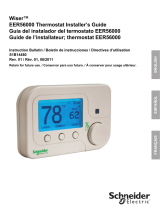
No utilizar en circuitos que excedan el voltaje especificado ya que los voltajes más altos
dañarán el control y pueden causar riesgos de electrocución o incendio.
No cortocircuite las terminales de la válvula de gas ni del control principal para probar-
los. Un cortocircuito o una conexión incorrecta dañarán el termostato y podría causar
lesiones personales y/o daños materiales.
La instalación del termostato y de todos los componentes del sistema de control debe
ajustarse a las normas del código NEC para los circuitos Clase II.
Instrucciones de instalación para:
Acción rápida 1E30N-910,
vertical 1E50N-301
SU TERMOSTATO REEMPLAZA
Sistema Modelos
Sistemas de sólo calor estándar
Calefactor eléctrico 1E30N-910
Bomba de calor (sin calor auxiliar o de emergencia) 1E50N-301
Sistemas de calefacción de gas o aceite
Sistemas de sólo calor milivoltios
PREPARACIÓN
Reúna las herramientas requeridas: taladro eléctrico, destornillador de hoja plana, tenazas/desai-
slador, nivel.
El no leer y seguir con cuidado todas las instrucciones antes de instalar o utilizar este
control podría causar lesiones personales y/o daños materiales.
DETALLES DEL TERMOSTATO
To rnillos
cautivos
CUBIERTA
BASE DEL
TERMOSTATO
PLACA DE PARED
SUBBASE
DE CONMUTACIÓN
S
Y
S
T
E
M
O
F
F
H
E
A
T
G
W
RH
To rnillo
de montaje
50
60 70 80
90
50 60 70 80 90
4
To rnillo
de montaje
To rnillo
de montaje
Figura 1. Subbase y placa de pared del termostato
Para evitar descargas eléctricas y/o daños al equipo, desconecte la alimentación eléctri-
ca en la caja de fusibles o disyuntores principal hasta que haya finalizado la instalación
del sistema.
Antes de retirar los cables de la subbase de conmutación del termostato viejo, identique cada cable
con la designación de la terminal de la que lo desconectó.
1. Retire el termostato viejo: Un termostato estándar consta de tres partes básicas:
a. La cubierta, que puede ser tipo bisagra o de broche.
b. La base, que se retira aojando todos los tornillos cautivos.
c. La subbase de conmutación, que se retira desenroscando los tornillos de montaje que
la sujetan a la pared o a la placa adaptadora.
Tome nota aquí del ajuste del anticipador del termostato viejo para referencia
futura y para utilizarlo en el paso 5.
El indicador del anticipador de calor, si es ajustable, se ajustará en uno de una serie de números
que representan la corriente nominal del control principal de su calefactor. El número será uno de los
siguientes: .2, .4, .8, etc. o 0.2, 0.4, 0.8, etc.
CÓMO RETIRAR EL TERMOSTATO VIEJO (continuación)
Si no aparece un anticipador de calor o una indicación, no se preocupe y continúe con el siguiente
paso.
¡ATENCIÓN! Este producto no contiene mercurio. No obstante, puede reemplazar un producto
que sí contiene mercurio.
No abra las celdas de mercurio. En el caso de que una celda se dañe, no toque el mercurio
derramado. Usando un par de guantes no absorbentes, recoja el mercurio derramado y viértalo en
un recipiente que pueda sellarse. Si se daña una celda, debe desecharse la unidad.
El mercurio no debe desecharse con los residuos domésticos. Para desechar la unidad que será
reemplazada por este equipo, colóquela en un recipiente adecuado. En www.white-rodgers.com,
se proporciona una lista de los lugares a los que se pueden enviar los productos que contienen
mercurio.
MONTAJE Y CONEXIONES ELÉCTRICAS
A. Retire la base de la subbase o placa de pared: Aoje los tornillos de la base y retírela.
B. Monte la subbase de conmutación o placa de pared: Utilice los tornillos suministrados para
montar la subbase o la placa de pared en la pared (vea la gura 1).
C. Conecte los cables a las terminales correspondientes: Para sistemas de dos cables (sólo
calor). Conecte un cable a RH y el otro a W.
D. Fije la base del termostato a la pared: Empuje con cuidado el cable que sobresale hacia
el interior de la pared y tape el oricio con un material ignífugo (como aislamiento de bra de
vidrio) para evitar que las corrientes de aire afecten el funcionamiento del termostato. Monte
la base del termostato a la subbase o placa de pared utilizando los tres tornillos cautivos de
la base del termostato (vea la gura 1). Ajuste bien los tornillos. Continúe con el paso Nº5.
CUADRO DE REFERENCIA DE TERMINALES
Designación de la terminal Designación de la terminal
del nuevo termostato de otros fabricantes
R H 4 R H M R 5 R
W W W H 4 W
Ajuste el anticipador en el valor del termostato viejo que anotó en el paso 3, o bien en el valor de
corriente nominal que gura en su control de calefacción principal. El anticipador de calor puede
ajustarse de 0.15 a 1.2 A. Ajuste el anticipador girando el brazo de contacto (vea la gura 2). El
ajuste del anticipador está indicado por los números de la base a los que apunta el indicador. Si
no está seguro en qué valor ajustar el anticipador, consulte al fabricante del calefactor el valor
recomendado.
Mueva el indicador en sentido antihorario para
alargar los ciclos de calefacción del sistema;
muévalo en sentido horario para acortar los
ciclos de calefacción. Los ajustes no deben ser de
más de 1/2 marca a la vez.
Para el funcionamiento milivoltio, gire el brazo de
contacto a Conexión de milivoltio.
Cubierta tipo broche: Alinee con cuidado la
cubierta con la base y engánchela en la base.
Figure 5. Anticipator adjustment
Gire el brazo de contacto para
ajustar el anticipador de calor
La flecha apunta a
la corriente nominal
del control principal
Figura 5. Ajuste del anticipador
Conexión de milivoltio
Nº DE PIEZA 37-6844B
Reemplaza 37-6844A
0920
CÓMO RETIRAR EL TERMOSTATO VIEJO
Tenga cuidado al fijar y pasar los cables para que no hagan cortocircuito con las termi-
nales adyacentes o con la parte trasera del termostato, ya que podrían causar lesiones
personales y/o daños materiales.
AJUSTE DE ANTICIPADOR DE CALOR
Figura 2. Ajuste del anticipador




